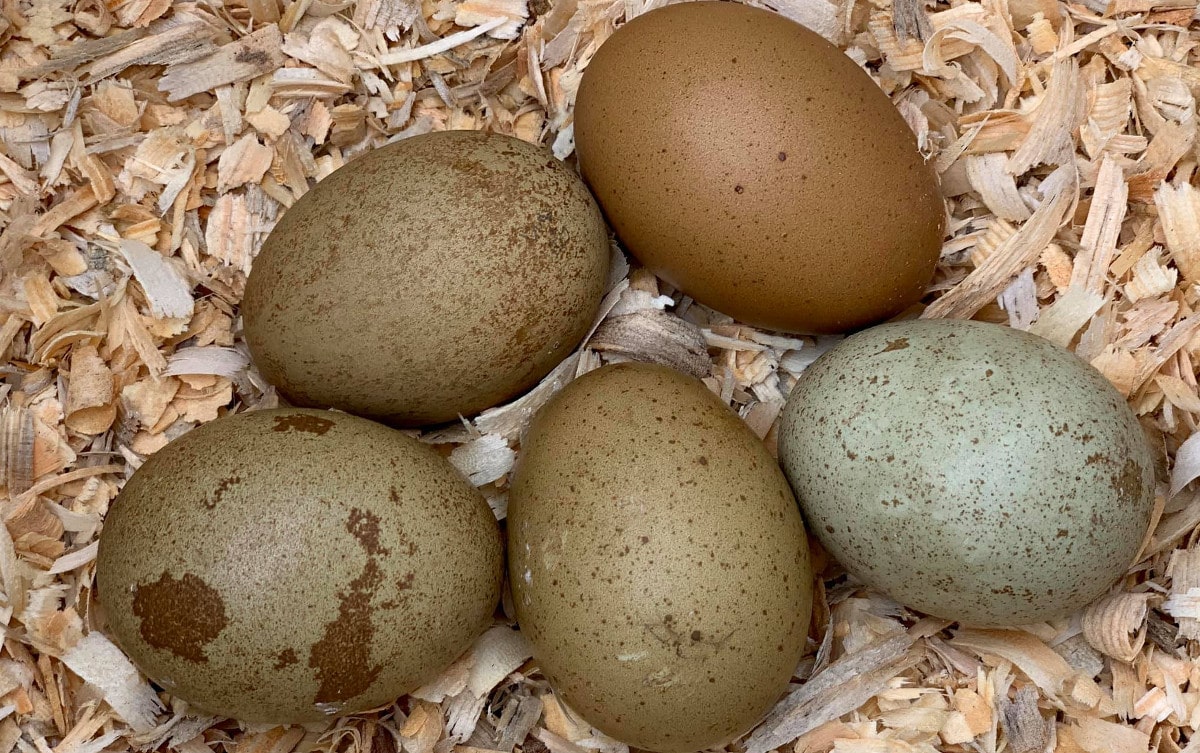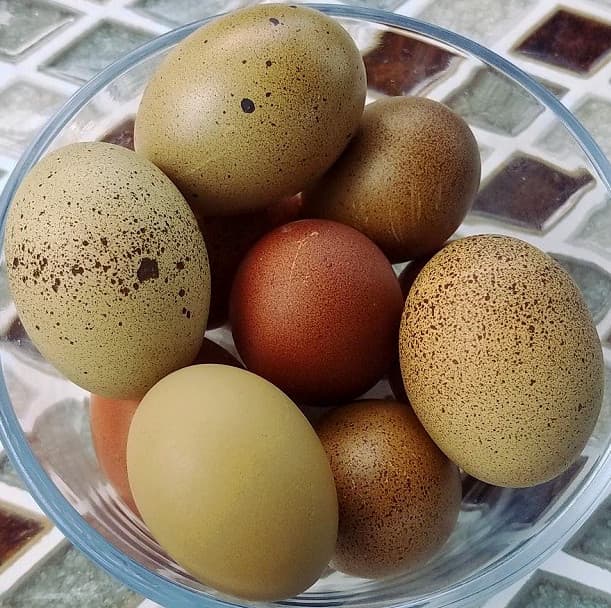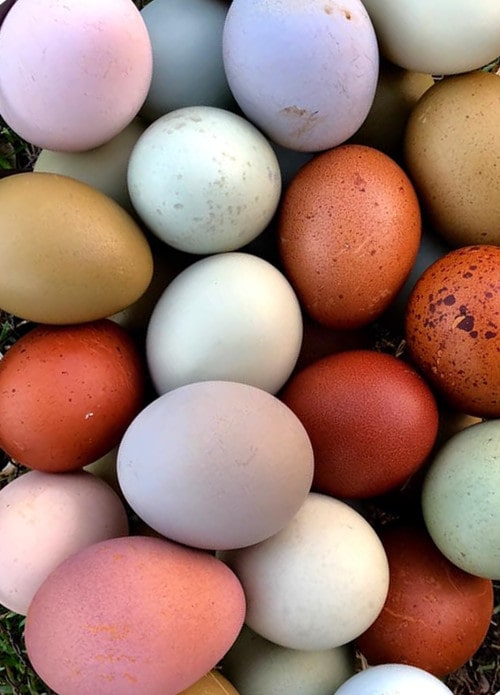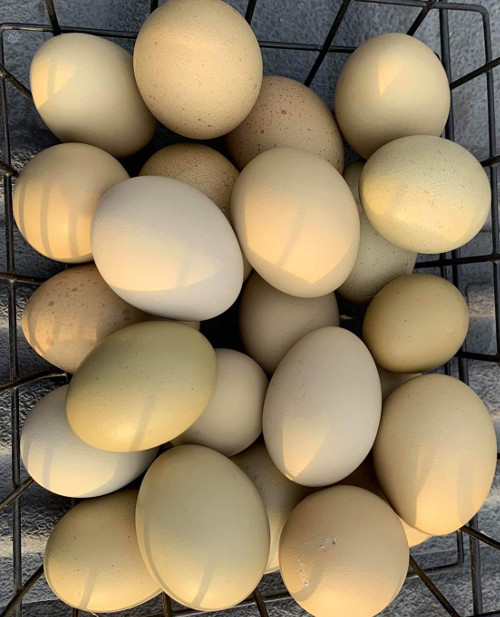Complete guide to Olive Egger chickens and how to breed them. With FAQ's

Table of Contents
- What is an Olive Egger chicken?
- Which chicken breeds are used to make Olive Eggers?
- What does an Olive Egger look like?
- How many eggs do olive eggers lay?
- What colour eggs do Olive Eggers lay?
- How to breed olive eggers:
- What are the breeds to make an olive Egger chicken?
- Can you breed two Olive Eggers to produce more Olive Eggers?
- Can Easter Eggers be used to create Olive Eggers?
- Where to get olive eggers and how much to pay for them:
- Olive Egger FAQ:
What is an Olive Egger chicken?
Olive egger Chickens are not a breed in their own right, They are a hybrid produced by crossing two different breeds, a cockerel from brown egg stock and an hen that lays blue eggs. Olive Eggers can be large fowl or bantams and be a surprising variety of shapes, sizes and colours. They are bred for the sole purpose of producing olive green eggs.
Below: An Olive Egger is a type of chicken that produces eggs with olive-drab shells. The colour olive is a dark yellowish-green, a bit like an unripe or green olive and drab means the colour tends toward brown.

The olive-drab shell colour is achieved by mating a hen from a blue egg laying breed with a cockerel dark brown egg laying breed. Blue shells are blue inside and out while brown eggshells have pigment only on the outside. The result of the cross breeding is that Olive Egger hens lay blue eggs with a brown pigment over the top, giving a shade of olive green. The darkness of the brown pigment determines the depth of the shade of olive.
Comb: Variable, depending on the parent stock but rose comb is dominant.
Popular Use: Can be used for both eggs and meat. The only purpose of breeding Olive Egger chickens is to produce eggs with olive coloured shells. The brown genes limit the number of eggs they can lay to no more than 200 each year. The colour of their eggs makes a striking addition to any egg basket.
If you are a local egg producer, adding olive shelled eggs to your inventory is certain to grab your customers’ attention.
Varieties: None recognised, as this is not a standard breed. Not being a true breed, Olive Eggers are not classified by the American Poultry Association. They would be difficult to classify, because they don’t all look alike, since they can be produced by mating several different breed combinations.
Temperament: Varies but for the most part friendly and easily tamed, especially if you bribe them with treats.
Skin Colour: Varies depending on the parent stock.
Plumage: Olive eggers can have many colours and patterns in their feathers and it is common for them to have crests and beards or muffs.
Weight: Usually large, but varies based on breeding. It is difficult to find bantams that lay the right sort of brown egg to breed olive eggers but it can be done.
Which chicken breeds are used to make Olive Eggers?
Olive Eggers are a cross between a breed that lays eggs with true blue shells and a breed that lays eggs with really dark brown shells. The blue egg layers might be Ameraucana, Araucana or Cream Legbar. The brown egg layers might be Barnevelder, Empordanesa, Marans, Penedesenca or Welsummer.
Below: It is possible to get a great many egg colours.

The darker the shell colour of the brown egg layer, the richer the shell colour of the Olive Egger’s eggs. Using a breed that lays lighter brown eggs results an F1 generation that lays eggs with shells that are a lighter, more khaki-like shade.
What does an Olive Egger look like?
The colour, size, and weight of Olive Eggers are determined by the breeds used to create them. These chickens therefore come in a variety of colours and comb styles.
Below: An Olive egger chicken.

Olive Eggers may or may not have pea combs, muffs, beards, or feathered legs, and may or may not be rump-less.
Olive Egger cockerels display the same variability.
How many eggs do olive eggers lay?
Olive egger chickens lay between 140 and 200 eggs per year depending on which parent stock you choose to breed them. Unfortunately the genes that come with the dark eggs also limit the productivity of the chickens. You can expect about and egg every two days or so or 3 eggs a week.
If the parent stock are good winter layer then the Olive egged offspring will tend to be as well.
What colour eggs do Olive Eggers lay?
The level of olive green colour is controlled by the presence of at least one blue egg gene for a blue eggshell and how many and intense the brown ink pigments are present.
Below: These are a very light olive, almost khaki coloured egg.

Green eggs can range from a pale green to a muddled brown green mess but the shells are always green inside. The richness of the olive will depend on what quality and quantity of brown pigment genes the brown egg layers are passing down.
If they're nice and strong dark brown genes, you'll get deep dark olive eggs. If you were using Marans for example and the eggs are more in the 3-5 range on the Marans scale, you'll get better colour olive.
Below: This is an egg from a hen bred with a Marans male, 4 on the Marans egg scale and bred to blue laying Legbar hens.

Brown isn't an eggshell colour as eggshells can only be two colours, white and blue. How brilliant the white is is controlled by how heavily a hen blooms the egg. Brown is a pigment on the outside of the shells and can be washed off. If you crack a white egg open it is white inside. If you crack a brown egg open it is also white inside as it's colour is controlled by the brown ink pigments applied to the exterior of the shell.
Blue is a gene caused by a retrovirus mutation in chickens. The retrovirus mutated the DNA and effected how the birds processed biliverdin. Biliverdin is a green bile like substance. In chickens it is excreted through their reproductive system. Specifically the portion where the eggshell is formed.
Brown egg colour is a series of at least thirteen separate genes that control the pigment coating that goes over an egg shell. It can be a light tan up to a dark chocolate.
Green eggs come from when a blue egg layer is crossed with a white egg layer that carries brown ink pigments. The intensity of the green is largely controlled by the amount of brown ink pigments the bird carries.
Bloom also can play a factor in the overall colour as well.
If you crack a blue egg open and remove the member you will see the inside of the shell is blue as well. If you crack a green egg open and remove the membrane it is blue inside not green. That is because the green is caused by the brown pigment being applied on the surface of the blue eggshell.
How to breed olive Eggers:
You can breed a brown-egg rooster to blue-egg hens, or a blue-egg rooster to brown-egg hens. Either cross will result in hens that lay olive green eggs. If your plan is to breed the Olive Egger hens back to the rooster to achieve F2 hens that lay darker olive eggs, you’ll want the rooster to be of a brown-egg breed.
In the F2 generation (original rooster bred to Olive Egger hens) about half the hens will lay darker olive eggs and half will lay brown eggs. If your Olive Eggers are a result of crossing a blue-egg rooster with brown-egg hens, and you breed the rooster back to the F1 Olive Egger hens, your F2 generation hens will lay eggs with paler green shells than those laid by the F1 hens.
Producing Olive Egger chickens provides an excellent introduction to the genetic complexities of chicken egg shell colours. Breeding Olive Eggers that lay eggs with a specific shade of olive green can be challenging, fun and fascinating.
Supposedly, the cockerel is responsible for passing on more of the brown enhancers than hens, there’s around 13 genes associated with just the brown I believe from memory.
Most people favour Marans over the blue layers. I’ve used Araucana over other breeds and had some lovely greens, including speckled and heavy bloomed (grey) eggs, but never struck the olive most strive for. But I was only using cuckoo Marans and Welsummer.
What is an F1 Olive Egger?
F1 is an abbreviation for filial one. The word filial derives from the Latin word filialis, meaning “of a son or daughter.”
F1 therefore refers to first offspring, the first generation resulting from crossing two different breeds for a specific purpose, in this case to achieve eggs with olive coloured shells. The first generation resulting from cross-breeding also tends to grow and lay better than either parent breed, thanks to a phenomenon known as hybrid vigour.
What is an F2 Olive Egger?
F2 refers to filial two, or the second generation resulting from cross breeding. Some chicken keepers breed F2 Olive Eggers to achieve eggs with shells that are a darker shade of olive than those produced by the first generation.
Others breed F2 Olive Eggers with the goal of producing chickens that lay eggs with a wider variety of green, brown, and blue shells.
What are the breeds to make an olive Egger chicken?
Hens that can be used to breed olive eggers include:
- Ameraucanas.
- Araucanas.
- Cream Crested Legbars.
Cockerels that can be used to breed olive eggers include:
- Barnevelder.
- Marans.
- Welsummer.
- Pendescenda
Can you breed two Olive Eggers to produce more Olive Eggers?
Yes, theoretically you can produce true breeding olive eggers. You need to create a flock that is homozygous for the blue eggshell gene and has a constant reliable brown ink output.
There are a few people I know of working on this but I have never succeeded and some are 12 generations into the project and still get inconsistent results.
Based upon the olive egg colour that most people tend to want and find optimum in appearance the best results seem to come from.a one time cross using a male who carries brown pigment genes from a line where the he s lay a five to six on the Marans scale and crossing him with a homozygous blue hen.
When the male is a from line of seven plus the olive colour gets muddled. When he's four or less you don't get olive.
Not if your goal is to obtain chickens that lay eggs with olive coloured shells. Being hybrids, Olive Eggers are genetically unstable. If you breed an olive egger rooster to an olive egger hen, the resulting offspring will not necessarily lay eggs with olive green shells. Instead, the chickens will lay eggs with a variety of shell colours, some of which may be olive.
The phenotype for olive eggs and dark brown eggs is fairly easy to manipulate. however the genotype is very difficult to stabilise, isolate and understand.
As of this time no one has successfully created true breeding olive egg layers. Many have tried. Many are trying but none have been successful. There are just too many factors and inhibitors that come into play.
True breeding green layers exist. The dark olive colour from a dark brown parent is difficult to carry forward.
Can Easter Eggers be used to create Olive Eggers?
An OE has one white egg gene, one blue egg gene and dark brown pigments. Depending on what colour your EE lays, yes, you can figure it out. Green= 1 blue + 1 white + light brown pigments; blue = at least one blue, and maybe a second blue or white; pink is considered on the scale of brown (pigments)
Not if your goal is to obtain hens that lay eggs with olive green shells. Easter Eggers produce eggs with several different shell colours, some of which may be white or brown. Even those that lay eggs with blue shells may not pass along the blue-shell gene to their offspring. Using Easter Eggers in the cross does not guarantee the creation of Olive Eggers.
Where to get olive eggers and how much to pay for them:
Olive egger hatching eggs can sometimes be bought from eBay if it is allowed in your country, otherwise there are dedicated groups on Facebook. Prices for hatching start from the $2 /£1 area but as always quality is likely to be more expensive.
Day old olive Egger chicks can be ordered from several hatcheries but expect to pay as much as $10 a chick for small numbers of sexed birds. Actual prices at the time of writing vary from $5.20 to $13.43 for sexed hens.
If you can't get hatchery birds you will need to breed your own.
Point of Lay Olive eggers start at $35 or around £25, if you can find someone willing to part with them.
Olive Egger FAQ:
Are Olive Eggers friendly?
No more or less so than other chickens. They are a hybrid of a great many different breeds and as such their temperament is not predictable like it is for certain breeds of heritage chicken. It is easy to tame and train chickens with a little time and a few treats.
At what age do Olive Eggers start laying?
From 24 to 30 weeks of age depending on when they were hatched in the year.
Can you get a speckled olive egg?
Yes. You need to select a breed that produces a speckled brown egg to breed from.
Below: Here is a speckled olive egg.

Do Olive Eggers go broody?
Yes. It depends on the parent fowl selected as to the broodiness of olive eggers but as it is mostly heritage breeds that go into their make up, expect them to be of average broodiness.
Do Olive eggers need special care or feed?
No, they don't need any special care or feed. Treat them the same as your ordinary chickens.
